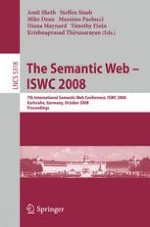The Web is a globalinformationspace consistingoflinked documents andlinked data. As the Web continues to grow and new technologies, modes of interaction, and applications are being developed, the task of the Semantic Web is to unlock the power of information available on the Web into a common semantic inf- mation space and to make it available for sharing and processing by automated tools as well as by people. Right now, the publication of large datasets on the Web, the opening of data access interfaces, and the encoding of the semantics of the data extend the current human-centric Web. Now, the Semantic Web c- munity is tackling the challenges of how to create and manage Semantic Web content, how to make Semantic Web applications robust and scalable, and how to organize and integrate information from di?erent sources for novel uses. To foster the exchange of ideas and collaboration, the International Semantic Web Conference brings together researchers and practitioners in relevant disciplines such as arti?cial intelligence, databases, social networks, distributed computing, Web engineering, information systems, natural language processing, soft c- puting, and human–computer interaction. This volume contains the main proceedings of ISWC 2008, which we are - cited to o?er to the growing community of researchers and practitioners of the Semantic Web. We got a tremendous response to our call for research papers from a truly international community of researchers and practitioners from 41 countries submitting 261 papers. Each paper receivedan averageof 3.
